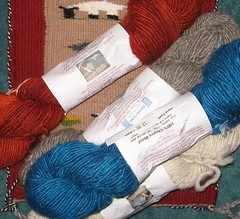The Red Post
First up, the least red:
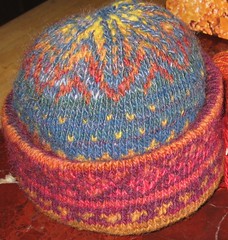
This is the pile of handspun yarn I bought at LaLana Wools in Taos. It's a fluffy woolen dubbelmossa, a doubled hat, so it is two layers thick all over, and four over the ears where it folds up. Warm! and best of all, it fits :). It was interesting knitting with handspun yarns spun by other people. These are singles, and knit up nicely, but skewed slightly when I washed the hat to block it:
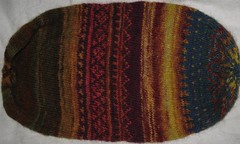
Singles have twist inherent, of course. That twist will torque in some knitted constructions, which can be used to advantage. Here, there is not enough skew to worry me; in a sweater I'd be more annoyed. I have enough yarn left for some mitts, perhaps fingerless, and again, the skew will no irritate me there either.
Next up is this cowl, now red:
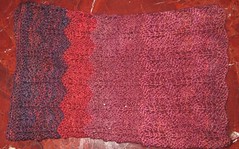
having been thrown into a dyepot. I have not worn it. I took a good look at it in its previous incarnation, and decided it was just not the right colors, so I threw it in a crock pot with some red dye (people who know me will not be surprised). Now, it goes nicely with everything I own! (Again, people who know me will not be surprised). I liked the close up of the colors:

Several yarns in the cowl were multi-colored, so they took the red dye in their own way. Yes, the irony of buying multi-colored rovings and over-dyeing them is not lost. I updated my Ravelry project page with these new photos: the pattern information is there too.
Speaking of red:
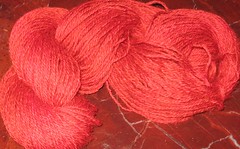
This is commercial yarn, from a flock in NY, which came to me white:
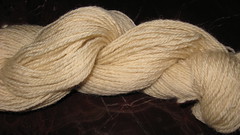
I actually thought about knitting it up in white, but, alas, could not. It is part of my allotment as a member of a wool-and-fiber CSA from Jenna's Coldantler farm in upstate NY. The wool is crisp and crunchy, good also for a hat, and will be taken with me as knitting on my next trip. I was not sure if the amount would be enough so I added a few skeins of handspun to go with it: the top one I over-dyed (and yes, it was multi-colored rovings I purchased to spin, then yes, I over-dyed the dyed yarn.....):
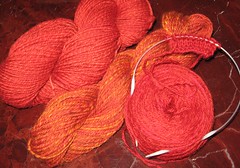
In the photo you can see some of my very favorite knitting needles, the funky all-one-piece nylon ones from the 50's, by Susan Bates. I loooooooove them, and other people seem to not, so I collect them whenever I find them (thrift stores, friend's stashes, estate sales, yard sales, whenever).
Also? I have neglected to brag about this:

A *gift* from Deb, as a thank you for weaving her silk shawl last summer. I put gift in quotes because I made her give it to me. It's embroidery, using her handspun yarns, and was her gallery piece for several conferences this year. At some point, I just told her she needed to give it to me, and she did. I should be embarrassed, but I'm not. I'm incorrigible :D!
Why all the red? Well, it's seasonal, cheerful, festive, pretty, I like it a lot, and one of my favorite little elves is wearing it this year:

Merry Christmas! or Happy Solstice! or happy other holiday, whatever you may celebrate.

This is the pile of handspun yarn I bought at LaLana Wools in Taos. It's a fluffy woolen dubbelmossa, a doubled hat, so it is two layers thick all over, and four over the ears where it folds up. Warm! and best of all, it fits :). It was interesting knitting with handspun yarns spun by other people. These are singles, and knit up nicely, but skewed slightly when I washed the hat to block it:

Singles have twist inherent, of course. That twist will torque in some knitted constructions, which can be used to advantage. Here, there is not enough skew to worry me; in a sweater I'd be more annoyed. I have enough yarn left for some mitts, perhaps fingerless, and again, the skew will no irritate me there either.
Next up is this cowl, now red:

having been thrown into a dyepot. I have not worn it. I took a good look at it in its previous incarnation, and decided it was just not the right colors, so I threw it in a crock pot with some red dye (people who know me will not be surprised). Now, it goes nicely with everything I own! (Again, people who know me will not be surprised). I liked the close up of the colors:

Several yarns in the cowl were multi-colored, so they took the red dye in their own way. Yes, the irony of buying multi-colored rovings and over-dyeing them is not lost. I updated my Ravelry project page with these new photos: the pattern information is there too.
Speaking of red:

This is commercial yarn, from a flock in NY, which came to me white:

I actually thought about knitting it up in white, but, alas, could not. It is part of my allotment as a member of a wool-and-fiber CSA from Jenna's Coldantler farm in upstate NY. The wool is crisp and crunchy, good also for a hat, and will be taken with me as knitting on my next trip. I was not sure if the amount would be enough so I added a few skeins of handspun to go with it: the top one I over-dyed (and yes, it was multi-colored rovings I purchased to spin, then yes, I over-dyed the dyed yarn.....):

In the photo you can see some of my very favorite knitting needles, the funky all-one-piece nylon ones from the 50's, by Susan Bates. I loooooooove them, and other people seem to not, so I collect them whenever I find them (thrift stores, friend's stashes, estate sales, yard sales, whenever).
Also? I have neglected to brag about this:

A *gift* from Deb, as a thank you for weaving her silk shawl last summer. I put gift in quotes because I made her give it to me. It's embroidery, using her handspun yarns, and was her gallery piece for several conferences this year. At some point, I just told her she needed to give it to me, and she did. I should be embarrassed, but I'm not. I'm incorrigible :D!
Why all the red? Well, it's seasonal, cheerful, festive, pretty, I like it a lot, and one of my favorite little elves is wearing it this year:

Merry Christmas! or Happy Solstice! or happy other holiday, whatever you may celebrate.

